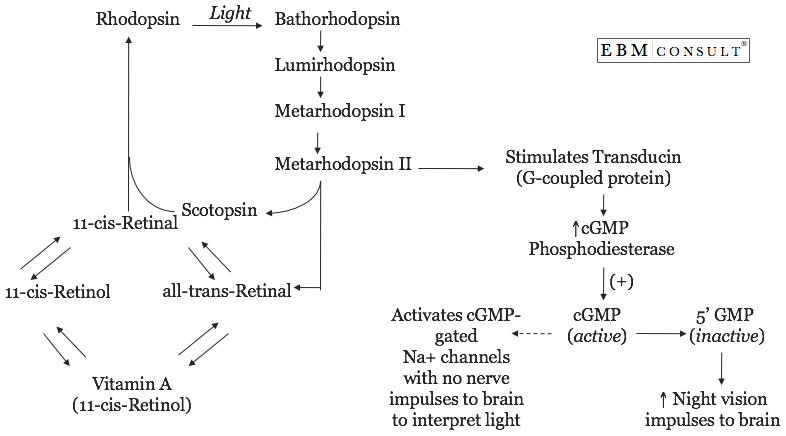Vitamin A (also called all-trans-retinol or
all-trans-retinoic acid) is a well-known fat soluble vitamin found in many
foods and dietary supplements. Vitamin A has been shown to be useful in
helping with nighttime vision, but not daytime vision.
Our ability to see is dependent on two main
photoreceptors that sit in the posterior aspect of the eye, the rods and cones
(with the rods outnumbering the cones by a ratio of 20:1).1 To be able to
see, light must first enter into and pass through the lens of the eye and then
travel through the posterior segment (vitreous chamber). Next, light must
travel through ten layers of the neural retina to get to the rods and cones.1
The rods and cones are made up of an inner segment that contains the nucleus
and an outer segment that is made up of discs that contain light-absorbing
photopigments.1 When comparing the two photoreceptors, the rods are
useful for night vision and the cones are useful for day vision. Vitamin
A is one of the required precursors for the formation of rhodopsin, the
photopigment found in rods. Rhodopsin helps us to see at night and
without vitamin A, rhodopsin cannot form and "night blindness"
occurs.2
Why is vitamin A needed for night vision to occur?
Vitamin A (all-trans-retinol) is a precursor to the formation of the
photopigment rhodopsin, which is located in the rods. In order for
rhodopsin to be formed, vitamin A must be converted to 11-cis-retinal.
This can occur in one of two ways. Vitamin A (all-trans-retinol)
can be converted to 11-cis-retinol by isomerase. This
11-cis-retinol can then be converted to 11-cis-retinal.
Alternatively, vitamin A (all-trans-retinol) can be converted to
all-trans-retinal which can then be converted to 11-cis-retinal.
Now that 11-cis-retinal has been formed by either method, it can combine with
scotopsin to form the rhodopsin. As rhodopsin absorbs light in the rods,
a conformational change occurs in 11-cis-retinal to become
all-trans-retinal. A conformational change also occurs in the opsin
fragment to form metarhodopsin II, which is the activated form of
rhodopsin. The metarhodopsin II then stimulates transducin, a G-coupled
protein found on the surface of the disk within the outer membrane in the rod
cell. This activation of transducin causes an activation in cGMP
phosphodiesterase, which will remove the cGMP mediated activation of cGMP-gated
channels that are letting Na+ ions leak into the rod cytoplasm resulting
in a hyperpolarization of that rod cell. Thus, in the presence of light,
the blockage of Na+ movement into the rod cell will result in a
hyperpolarization of that rod cell which then allows messages about light being
seen during night vision to be sent to the brain for final interpretation.

In addition to vitamin A's role in helping the
rods in our eyes convert light into neuronal impulses for our brain, it is also
required to maintain normal differentiation of the cornea and conjunctival
membranes which helps prevent other abnormal eye conditions, such as
xerophthalmia. The Food
and Nutrition Board, Institute of Medicine - National Academy of Sciences advises
that the Recommended Daily Allowances (RDA; given below as retinol activity
equivalents (RAE's)) and Tolerable Upper Intake Level (ULs) be the following:
- Children 1 to 3
years of age: RDA = 300 mg/d with UL = 600mg/d.
- Children 4 to 8
years of age: RDA = 400 mg/d with UL = 900mg/d.
- Males & Females
9 to 13 years of age: RDA = 600 mg/d with UL = 1,700mg/d.
- 14 to 18 years of
age: RDA = 700mg/d for females and 900mg/d for males with UL = 2,800mg/d.
- > 18 years of
age: RDA = 700mg/d for females and 900mg/d for males with UL = 3,000mg/d.
If the supplement is measured in International
Units (IU), there is no known direct equivalent from RAE to IU, but it can be
estimated how many RAEs there are in that supplement. First check the
label on the supplement and determine the source of vitamin A (either retinol
or beta-carotene). If it is retinol, multiply the IU by 0.3 to get the
micrograms of RAE or multiply the number of micrograms of RAE by 3.3 to get the
number of IU. If it is beta-carotene, multiply the number of IUs by 0.025
to get the number of micrograms of RAE or multiply the number of RAE by 39.6 to
get the number of IUs.
As with any medication or supplement, excessive
doses or unnecessary exposure can be harmful. Therefore, doses above the
UL should be avoided because Vitamin A has been associated with an increase
risk for hip fracture in postmenopausal women, lung cancer, cardiovascular
mortality and total mortality.3-6.
References:
- Wässle H, Boycott BB. Functional architecture of the mammalian retina. Physiol Rev 1991;71(2):447-80.
- Wald G. Molecular basis of visual excitation. Science 1968;162(850):230-9.
- Feskanich
D, Singh V, Willett WC et al. Vitamin A intake and hip fractures among
postmenopausal women. JAMA 2002;287(1):47-54.
- No
Authors. The effect of vitamin E and beta carotene on the incidence of
lung cancer and other cancers in male smokers. The Alpha-Tocopherol,
Beta Carotene Cancer Prevention Study Group. N Engl J Med
1994;330(15):1029-35.
- Omenn
GS, Goodman GE, Thornquist MD et al. Effects of a combination of beta
carotene and vitamin A on lung cancer and cardiovascular disease. N Engl J Med 1996;334(18):1150-5.
- Omenn
GS, Goodman GE, Thronquist MD et al. Risk factors for lung cancer and
for itnervention effects in CARET, the Beta-Carotene and Retinol
Efficacy Trial. J Natl Cancer Inst 1996;88(21):1550-9.


